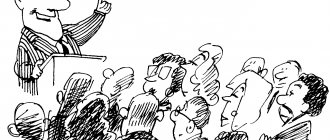“Speech is the clothing of thoughts, and eloquence is its elegant attire.”
Every day we convince someone of the correctness of our words and, perhaps, use oratory, if we have the skills.
We can participate in negotiations, sell, speak publicly, polemicize and argue. We are constantly trying to prove and defend our rights or point of view.
Every day, television announcers, print journalists, sellers and advertisers, bosses and comrades try to convince us of this or that.
Facts, reasons, arguments, reasons hover around us. We want to argue our positions in front of any audience and speak convincingly so that the opponent is intrigued and interested in our speech. What skills are needed for this, and what is public speaking?
Who is a speaker
An orator is a person who has oratory abilities, which consist of the ability to speak beautifully and convincingly, to master the tools of acting, and to have psychological knowledge.
The talent of eloquence can be innate. It is even believed that each of us has it, only to varying degrees. This means that anyone can develop this gift, taking into account individual characteristics and working on themselves.
With the development of oratorical skills comes the skill of public speaking, which has its own properties:
- special content of speech - linguistic and non-verbal, in the form of facial expressions and gestures, methods of influencing the listener;
- focus - receiving feedback from the audience;
- effectiveness - as a result of the psychological state of the speaker and his authority among the public.
But you can structure your speech competently if you use the rules of oratory:
- The presentation should be structured for better assimilation and accessible to understanding.
- Speech that is correct, expressive and without filler words is capable of capturing the attention of the public for a long time.
- The information provided must be useful and truthful.
- The emotional content of the speech and the dry language of numbers will create balance and will not allow the listener’s interest to evaporate.
- His attention should not be abused; conciseness and informational capacity of speech are welcome.
- The beginning of a speech and its final part have a greater effect on the audience than the content - this should be taken into account in the compositional structure of the speech.
- You need to speak to the audience in a language they understand, taking into account their intellectual level, age category, and social affiliation.
And then she will have the qualities necessary for oratory:
The image of a talented speaker is charismatic and closely associated with such characteristics and traits as self-confidence, inspiration, erudition, the ability to improvise, vividness of thought, strong voice, and expressive gestures.
We’ll talk later about how to learn public speaking on your own.
From rhetorical treatises
This part of the book includes fragments from two important treatises - “On the best form of speakers” ( translated by V. A. Alekseev, F. F. Zelinsky
) and “Orator” (
translated by M. L. Gasparov
). We sometimes perceive rhetoric solely as a practical skill to speak clearly and convincingly. But for Cicero, rhetoric is not just exciting speeches, it is a theater where all citizens meet and together develop a serious state position. For Cicero, a rhetorician who simply influences the crowd is bad, and a rhetorician who teaches responsible judgment to the crowd is good. Cicero’s goal is to prove that a rhetorician-philosopher will always defeat a simple rhetorician: the latter is not protected from bad taste, nor from pomposity, nor from following ready-made models, while the rhetorician-philosopher is critical of them, modest and cautious, and therefore his “acting ” is much more attractive even to the public, who initially did not trust him.In his treatise “On the Best Form of Orators,” Cicero formulates how a rhetorician can reveal his own talents, drawing on different genres of literature and different habits of perception. The purpose of the treatise is to show that a good speaker can work in any genre, use any honest arguments and thereby contribute to the prosperity of all aspects of the life of the state.
The treatise "The Orator" gives a number of practical tips regarding the selection of words and arguments, choice of style and persuasion strategy. Unlike his Greek predecessors, Cicero pays a lot of attention to the performance itself, the course of the speech, and talks about improvisation and the role of the speaker as an actor. It is important for him that the speaker not simply choose between the dryness and severity of the Attic school and the pomp and show of the Asiatic school, these two rival schools of rhetoric, which originated respectively in Athens and the Greek Middle East, but understand the shortcomings of both schools and what is simple Following student recipes, even the most excellent ones, will not create an ideal speaker. Cicero can be very ironic, arguing with both the Atticists and the Asianists; but with all his political conservatism, he calls on the speaker to update his tools and unexpected improvisations.
Types of eloquence
Depending on the composition of the audience and the topic, eloquence is divided into types:
Oratory speech can have different goals of influencing the listener and it happens:
- informational, introduces new facts, information, knowledge;
- entertaining, has a fun character;
- persuasive, in which the speaker seeks the listener's agreement with his point of view;
- uplifting, emotionally inspiring;
- calling to action, agitating to take action.
Facts about the profession
The ability to communicate skillfully and attract the attention of others with your speech is not given to every person. However, it is worth understanding that the possession of public speaking skills is one of the most important components of success.
Logical arrangement of thoughts, combining words into correct informational sentences give the speaker advantages that help win over people.
Currently, there are courses where those interested can undergo training and acquire public speaking skills.
The structure of oratory speech
In order for a public speech to achieve its goal and leave no one indifferent, it is built according to the plan and content in a certain order, which is called composition.
The introduction should attract attention, interest, establish contact with the audience, and give an idea of the topic of the upcoming message with a brief description of the issue.
The main part of a public speaking speech is the presentation of the material itself, argumentation, and the use of facts and logical evidence.
The conclusion is intended to summarize and generalize what has been said, emphasize the main idea, draw conclusions, and inspire listeners.
It is advisable to approach creatively when working on a composition. While maintaining a clear sequence and consistency of its elements, it is important not to lose your individual style.
History of development
As noted earlier, orators have enjoyed great success since ancient times. As a separate specialization, this skill appeared in Ancient Greece, where public speaking was the basis of state influence. Prophets, teachers in Buddhism and other leaders of past eras can also be classified as speakers.
In modern times, not only politicians and large businessmen resort to teaching public speaking skills, but also coaches who teach people various skills.
Features of oratory
Oratory speech is characterized by the following features:
Oral presentation. The process of communication with the audience occurs directly when voicing thoughts. Texts for public speaking are learned by ear and structured in such a way as to be easy to understand.
Availability of feedback. A good speaker feels the audience. He distinguishes mood, catches reactions to what is said, guesses emerging questions and flexibly builds further dialogue.
Use of various means of communication. The use of gestures, pantomime, intonation and other non-verbal methods is inherent in oratory, which distinguishes it from ordinary oral speech.
The relationship between the text prepared for speech and its oral interpretation. Choosing the right tone of communication helps to present information in an intelligible form and find contact with the audience.
Oratorical techniques
Oratory techniques are used to improve the perception of information. They work either by orienting the listener to figurative perception, or by stimulating his mental activity.
For example:
- visual comparisons and short illustrative examples are especially appropriate when conveying numerical material;
- repeating what has already been said in other words creates a new image;
- the allegory clearly illustrates the speaker’s ideas and thoughts;
- antithesis by contrast enhances their perception;
- hyperbole exaggerates those points that need to be paid attention to;
- rhetorical questions do not require an answer, but stir up interest;
- an insertion when a casual remark made draws attention to what was said;
- unexpected words and actions heighten the listener's curiosity.
Let's sum it up
This article is an information source for both children and adults. After all, you can become a speaker at any age, the main thing is to find your topic and people who will be interested in it. These skills will also be useful in business and personnel management.
We told what kind of profession a speaker is, discussed all the pros and cons of this type of activity and gave a description of the professional qualities that such a specialist should have.
Now you are not faced with the question: “Who is this speaker?”
How to develop speaking skills
To master the secrets of oratory, you can enroll in courses and trainings on rhetoric, take lessons for beginners, choose online training, or study a self-instruction manual on eloquence. All these options are offered to our attention by the vast Internet.
If you like independent training in the development of public speaking, let's work on the technique of delivering a speech, prepare for a speech, learn how to interact with the audience and take on board some practical tips.
Speech technique
The sound of speech you want to listen to depends on the following components:
- Breath. The pace should be measured, with the inhalation being shorter than the exhalation. Do not inhale “all the way” so that you have the opportunity to take a breath. It's the same with exhalation. Special exercises help improve speech. For example, developing the skill of breathing from the bottom of your lungs will make your voice stronger and your speech fluent.
- Volume. By controlling his voice, a speaker influences the audience's perception of what he says. If your voice is naturally quiet, you can make it louder. To do this, read expressively out loud, count to ten as you exhale, gradually increasing the volume of your voice.
- Diction. Tongue twisters will help you speak clearly, clearly pronouncing sounds, if you are not lazy and do not forget to load your articulatory apparatus with them.
- Pace. We must try to express our thoughts at an average pace, without sputtering words or stretching them out. Since the temperament and internal state of a person at the time of the performance plays an important role here, it is important to calm down and tune in to a fruitful dialogue with the audience.
- Intonation. With its help, your speech will be remembered by the listener because it will be alive. Practice reading works of art aloud with expression, just like in school.
Preparing for the performance
At this stage, the text of the speech is prepared. We already know what a properly composed public speech should be. In order not to read from what is written, you should first of all memorize the text, and draw up a plan and main points for the meeting with the audience.
To be ready for improvisation, you must have developed logical and imaginative thinking, have a rich vocabulary and a broad outlook. Read different literature, keep abreast of social events.
To maintain the proper mood among the audience, stock up on a number of interesting facts, light jokes, and entertaining short stories.
To avoid being caught off guard by the technical side of your presentation, be aware of organizational issues: hall, audio equipment, video materials.
Oratory for children
Today, rhetoric, as a scientific discipline about the art of oratory, is also in demand for the harmonious development of children. It develops the child’s personal qualities, teaches them the ability to communicate, express their thoughts competently and confidently, conduct a dialogue using intonation and facial expressions, and acquire the first skills of public speaking.
The objectives of teaching rhetoric are:
You can also work with your children at home:
- work on your speech technique, pronouncing tongue twisters;
- learn polite communication;
- read and talk a lot on different topics to increase your vocabulary;
- organize theatrical performances to develop acting skills;
- learn and read poetry with expression;
- practice performing in front of family and friends.
These classes will help your child become more confident and not be shy at public events, teach them how to establish contacts with people, and reveal their creative potential.










